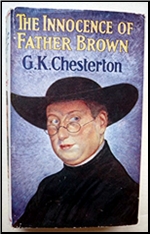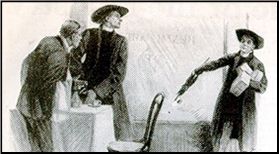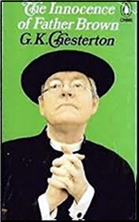Wed 13 May 2020
A 1001 Midnights Review: G. K. CHESTERTON. The Innocence of Father Brown.
Posted by Steve under 1001 Midnights , Reviews[3] Comments
by Edward D. Hoch
  Â
G. K. CHESTERTON. The Innocence of Father Brown. Cassell, UK, hardcover, 1911. Lane, US, hardcover, 1911. Many reprint editions exist.

   A cornerstone volume, Chesterton’s Innocence of Father Brown can lay claim to greatness on two counts: It introduced the priest detective whose adventures are still popular three-quarters of a century later, and it contains more classic short stories than almost any other mystery collection before or since.
   All twelve of its stories deserve special mention. The opening story, “The Blue Cross,” long an anthology and textbook favorite, tells of the first meeting of Father Brown and the master thief Flambeau, who would later become his friend and associate on many cases. “The Secret Garden” has a dual impossibility – the appearance of a beheaded corpse inside a locked and guarded garden, and the disappearance of another man from the same garden. “The Queer Feet” turns upon a brilliant bit of psychology and is a favorite of several critics.
   “The Flying Star†involves a diamond theft at a Christmas party, and is Flambcau’s last crime. “The Invisible Man” is probably the most famous Father Brown story of all — so famous, in fact, that its solution is known to people who have never read it. Whether Smythe really could have been murdered in his guarded apartment building without anyone seeing the killer is a matter of some dispute, but the story is memorable nonetheless.

  “The Honour of Israel Gow” presents Father Brown with a number of bizarre objects, seemingly unrelated, The solution, simple yet startling, reveals a strange sort of honesty rather than a crime. In “The Wrong Shape” a man is stabbed to death with a curved dagger in a locked room. leaving an oddly shaped suicide note. “The Sins of Prince Saradine†is about a murder plot and a duel with rapiers. “The Hammer of God,” one of the three or four best Father Brown stories, combines a seemingly superhuman murder beside a great Gothic church with a solution that is simple and sa1isfying.

   “The Eye of Apollo” deals with a cult of sun worshipers and a unique murder method. “The Sign of the Broken Sword,” perhaps the cleverest and most enjoyable story in the volume, full of paradox and allowing Father Brown to practice some pseudo-historical detection, offers Chesterton’s dazzling answer to the question “Where would a wise man hide a body?” The final story, “The Three Tools of Death,” is about an apparently brutal murder.
   All twelve. offer a nice feeling of life in Edwardian England, and if Father Brown lacks the colorful eccentricities of Sherlock Holmes, if his solutions are often more intuition than deduction, this book is still a masterpiece, the single volume by which G .K. Chesterton is most likely to be remembered.
   ———
Reprinted with permission from 1001 Midnights, edited by Bill Pronzini & Marcia Muller and published by The Battered Silicon Dispatch Box, 2007.  Copyright © 1986, 2007 by the Pronzini-Muller Family Trust.
  Â
NOTE: Ed Hoch’s review of The Incredulity of Father Brown was posted here earlier this month.
May 13th, 2020 at 8:19 pm
It’s easy to get so lost in Chesterton’s flaws and prejudices and lose sight of how important he and Father Brown are and just how good a writer he was whether it is the cleverness of Father Brown’s stories and other detective collections, the somewhat spiked humor of THE MAN WHO WAS THURSDAY, the whimsy of some of his fantasy, his poetry, or his numerous essays whether you agree with him or not.
One thing I miss not having cable is once in a while turning into the Catholic channel to catch an episode of Chesterton featuring one of the travelling debates he used to do with George Bernard Shaw.
Whatever else he was one of the most quotable men ever.
May 13th, 2020 at 8:29 pm
No one can say they are a fan of Golden Age detective fiction without having read Father Brown.
August 20th, 2023 at 2:12 pm
[…] of Father Brown has been reviewed, among others, by Nick Fuller at The Grandest Game in the World, Edward D. Hoch at Mystery File, Aidan Brack at Mysteries Ahoy! Bev Hankins at My Reader’s Block and at FictionFan’s […]